
Browse an alphabetical list of photographs. These historical images portray people, places, and events before, during, and after World War II and the Holocaust.
<< Previous | Displaying results 751-798 of 2641 for "Photo" | Next >>
German troops view the burning of a village in the Rogachyevo district of Gomel, Belarus, 1941.
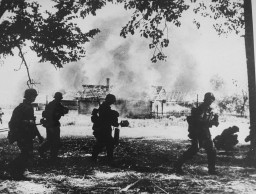
Following the German invasion of Poland on September 1, 1939, Warsaw suffered heavy air attacks and artillery bombardment. German troops entered the city on September 29, shortly after its surrender. This photograph was taken by Julien Bryan, an American documentary filmmaker who captured the German bombardment and its impact on the Polish citizenry. Warsaw, Poland, ca. 1939.
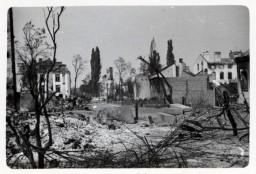
The damaged lintel above a Torah ark from a synagogue that was destroyed during Kristallnacht. Nentershausen, Germany, 1938.
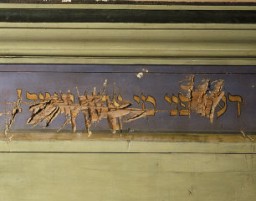
SS officers stand among the rubble of Lidice during the demolition of the town's ruins in reprisal for the assasination of Reinhard Heydrich. Czechoslovakia, between June 10 and June 30, 1942.
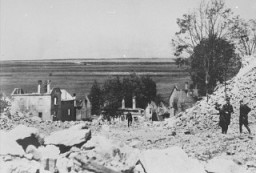
Destruction of the Dortmund synagogue during Kristallnacht (the "Night of Broken Glass"). Germany, November 1938.
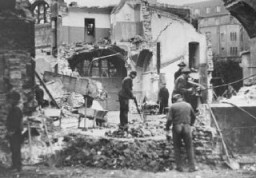
Dietrich Bonhoeffer, German Protestant theologian who was executed in the Flossenbürg concentration camp on April 9, 1945. Germany, date uncertain.
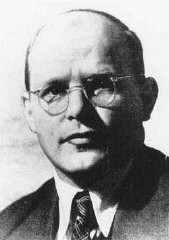
A US flag hangs from the ceiling of the main dining room at the Landsberg displaced persons camp. Germany, December 6, 1945.

Diploma issued by the International Refugee Organization (IRO) certifying that Naftali Froimowicz was trained as a shoemaker in Turin, Italy on November 14, 1949. Froimowicz lived in several displaced persons (DP) camps in Italy after the war.
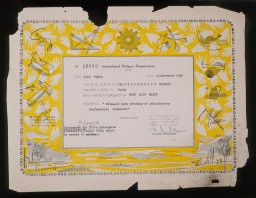
A Jewish refugee couple poses on the gangway of the MS St. Louis as they disembark from the ship in Antwerp. Belgium, June 17, 1939.
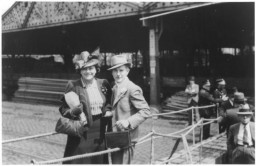
Displaced Iraqis wait for food distribution at an internally displaced persons (IDP) camp on the outskirts of Erbil, Iraqi Kurdistan. September 2, 2015.
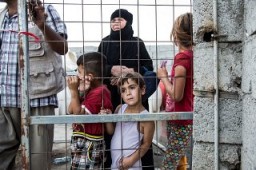
Displaced persons stand on a train platform in the weeks after the end of World War II in Europe. Kolleda, Germany, June 1945.
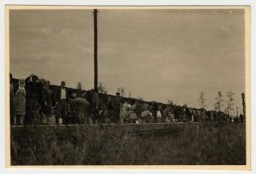
Displaced persons knitting and embroidering at a camp administered by the United Nations Relief and Rehabilitation Administration (UNRRA). Sweden, after May 1945.
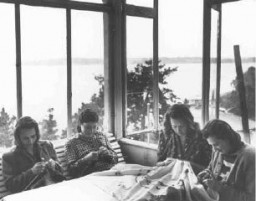
Jewish displaced persons (DPs) converse on the streets of the Neu Freimann DP camp, circa 1946–1948.The photographer, Jack Sutin, lived at the camp with his family and worked as a camp administrator and photojournalist.
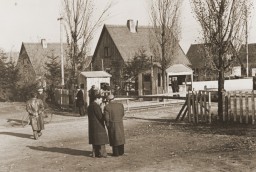
View of a displaced persons camp in Salzburg, in the American occupation zone. Salzburg, Austria, May 25, 1945.
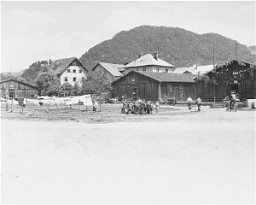
A man and his son, displaced persons (DPs) from Romania, wait on a cot in the Rothschild Hospital displaced persons camp in Vienna. Austria, October 15, 1947.

Displaced persons wait next to their suitcases and bundles, place uncertain, ca. 1947.

Assembly point for Poles displaced by the German Race and Resettlement Main Office (RuSHA). Sol, Poland, September 24, 1940.
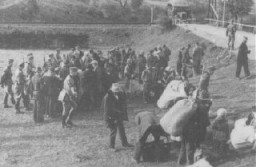
A display, entitled "British Freemasonry," at an antisemitic and anti-Masonic exhibition in Berlin. The display shows a Torah scroll and a picture of King Edward bearing Masonic regalia. Berlin, Germany, March 7, 1941.
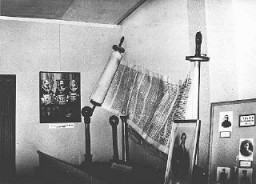
Display from "Der ewige Jude" (The Eternal Jew), a Nazi antisemitic exhibit which claimed that Jews heavily dominated the German performing arts. A phrase at the top of the display states "Shameless Entertainment." Berlin, Germany, November 11, 1938.
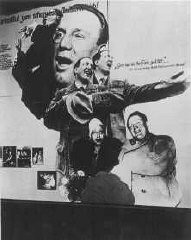
A Hochheim parade float proceeds down the Kirchstrasse, passing by a display box for Der Stürmer, an antisemitic newspaper. The display box bears the slogan, "Without a solution to the Jewish question, there is no salvation for the German people." Hochheim am Main, Germany, circa 1934–1940.
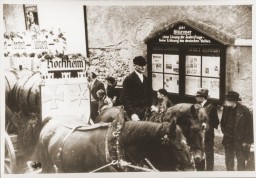
Djakovo camp, where Croatian Jews were imprisoned and killed, was located in this former flour mill. Yugoslavia, wartime.
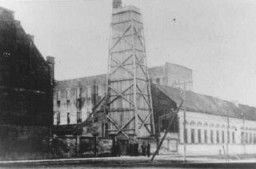
Document issued by the Regional Agricultural Mercantile Cooperative in Busko-Zdroj certifying that Bronislawa Tymejko (the false identity of Sophie Schwarzwald's mother, Laura Schwarzwald) was employed by the cooperative, dated November 1942.
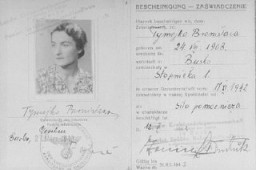
View of the mimeograph room in the Palace of Justice at Nuremberg after the transcripts on the sentencing of the defendants in the High Command Case had been run off. The reproduction of documents during the Nuremberg trials, often in four languages, was a huge logistical challenge. Nuremberg, Germany, 1948. (Source record ID: A65III/RA-121-D)

Four of Norman's sisters, the maid, and Norman's mother, Esther, do laundry in the yard of their home. Kolbuszowa, Poland, 1934.
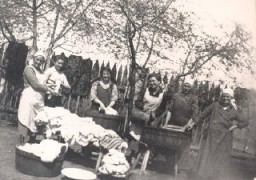
In 1942, seven-year-old Inge Auerbacher was deported with her parents to the Theresienstadt ghetto. She brought along this doll, named “Marlene” after German actress Marlene Dietrich, which her grandmother had given her. It would remain with Inge throughout her three years of imprisonment in the ghetto.
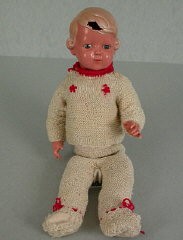

Displaced persons (DPs), Lusia Gliklich (left) and Andzia Dell, stand beside the sign in front of the Düppel Center DP camp, also called Schlachtensee.
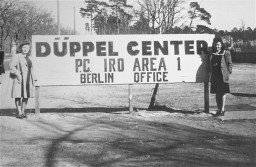
Dr. Fritz Klein stands among corpses in a mass grave at Bergen-Belsen, after the liberation of the camp. He was required to assist in the burial of inmates who died there. Klein was a camp doctor at both Auschwitz and Bergen-Belsen. Germany, after April 15, 1945.

Dr. Joseph Jaksy, who rescued 25 Jews during the war. He provided them with hiding places, money, medicine and forged identification papers. Jaksy was named "Righteous Among the Nations." Czechoslovakia, prewar.
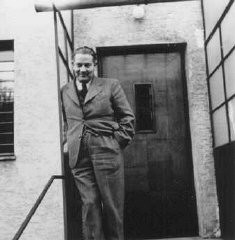
Portrait of Dr. Mohamed Helmy. Helmy was an Egyptian physician living in Berlin. He worked together with Frieda Szturmann, a local German woman, to help save a Jewish family.
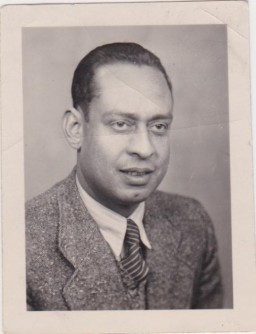
Dr. Mohamed Helmy and his wife, Emmi Ernst. During the Nazi era, they were forbidden from marrying because Dr. Helmy was not an Aryan. They were finally able to marry after the end of World War II.
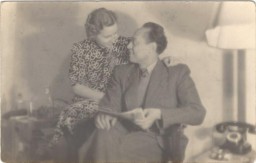
Dr. Robert Ritter and Eva Justin examine a young boy interned in a Zigeunerlager (“Gypsy camp”). Cologne, Germany, c. 1937-1940. During the Nazi era, Dr. Robert Ritter was a leading authority on the racial classification of people pejoratively labeled “Zigeuner” (“Gypsies”). Ritter’s research was in a field called eugenics, or what the Nazis called “racial hygiene.” Ritter worked with a small team of racial hygienists. Among them were Eva Justin and Sophie Ehrhardt. Most of the people…

Dr. Robert Ritter talks to several residents in a Zigeunerlager ("Gypsy camp"). Hamburg, Germany, 1940. During the Nazi era, Dr. Robert Ritter was a leading authority on the racial classification of people pejoratively labeled “Zigeuner” (“Gypsies”). Ritter’s research was in a field called eugenics, or what the Nazis called “racial hygiene.” Ritter worked with a small team of racial hygienists. Among them were Eva Justin and Sophie Ehrhardt. Most of the people whom Ritter studied and…
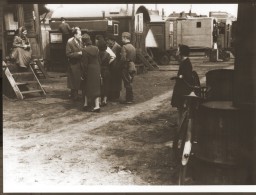
A dress worn by hidden child in Baarn, the Netherlands. The dress was donated to the United States Holocaust Memorial Museum in 2002 by Vera Waisvisz-Reiss.
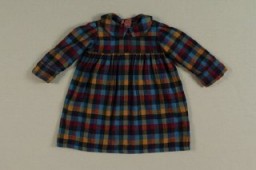
A farmer and his sons walk in the face of a dust storm. Cimarron County, Oklahoma. 1936
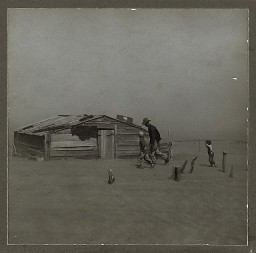
Dutch Jews who have recently arrived in the Theresienstadt ghetto. Czechoslovakia, February 1944.
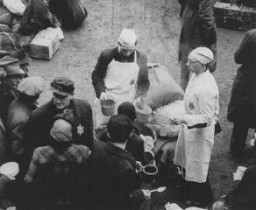
Semmy Woortman-Glasoog with Lientje, a 9-month-old Jewish girl she hid. Woortman-Glasoog was active in a network which found foster homes, hiding places, and false papers for Jewish children. She was later named "Righteous Among the Nations." Amsterdam, the Netherlands, between 1942 and 1944.

Dutch Seventh-day Adventist Johan Weidner headed the rescue organization "Dutch-Paris," which smuggled Jewish refugees into Switzerland and Spain. France, ca. 1940.
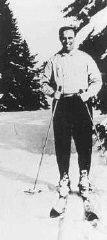
A man works outside his family's dwelling in a Roma (Gypsy) encampment in the city of Haarlem. The Netherlands, October–November 1940.
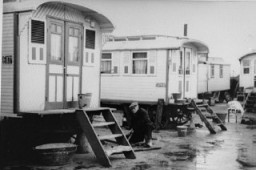
An early view of the Dachau concentration camp. Columns of prisoners are visible behind the barbed wire. Dachau, Germany, May 24, 1933.
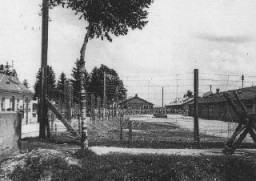
Units of a German armored division on the eastern front in February 1944. Soviet forces, largely on the offensive since the battle of Stalingrad, pushed German troops to the borders of East Prussia by the end of 1944. Soviet Union, February 1944.
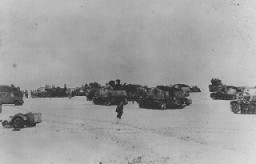
Barracks in the Ebelsberg camp for Jewish displaced persons. Ebelsberg, Austria, July 1947.
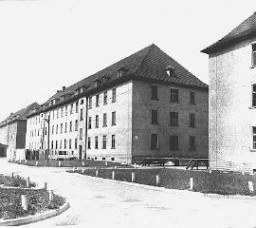
Eduard, Elisabeth, and Alexander Hornemann. The boys, victims of tuberculosis medical experiments at Neuengamme concentration camp, were murdered shortly before liberation. Elisabeth died of typhus in Auschwitz. The Netherlands, prewar.
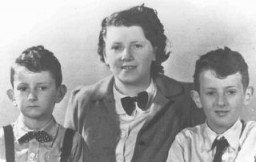
Defendant Adolf Eichmann stands as he is sentenced to death by the court. The execution of Eichmann remains the only time the State of Israel has enacted a death sentence. Jerusalem, Israel, December 15, 1961.
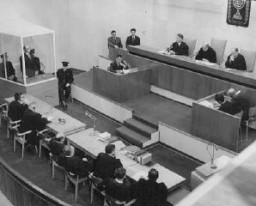
While on a tour of the newly liberated concentration camp, General Dwight Eisenhower and other high-ranking US Army officers view the bodies of prisoners who were killed during the evacuation of Ohrdruf. Ohrdruf, Germany April 12, 1945.
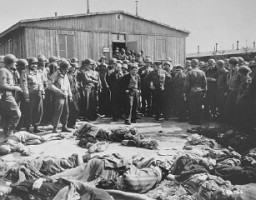
Generals Dwight D. Eisenhower and George S. Patton discuss Allied military operations in North Africa. Djebel Kouif, Algeria, March 16, 1943.
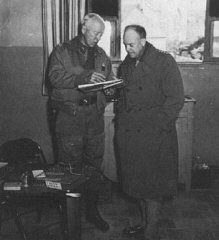
US General Dwight D. Eisenhower and General Troy Middleton, commanding general of the XVIII Corps, Third US Army, tour the newly liberated Ohrdruf concentration camp. Ohrdruf, Germany, April 12, 1945.
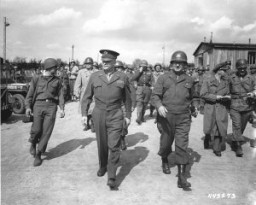
During an official tour of the newly liberated Ohrdruf concentration camp, an Austrian Jewish survivor describes to General Dwight Eisenhower and the members of his entourage the use of the gallows in the camp. Among those pictured is Jules Grad, correspondent for the US Army newspaper Stars and Stripes (on the right). Ohrdruf, Germany, April 12, 1945.
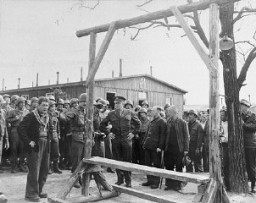
We would like to thank Crown Family Philanthropies, Abe and Ida Cooper Foundation, the Claims Conference, EVZ, and BMF for supporting the ongoing work to create content and resources for the Holocaust Encyclopedia. View the list of donor acknowledgement.